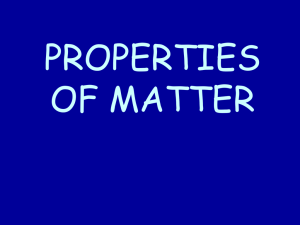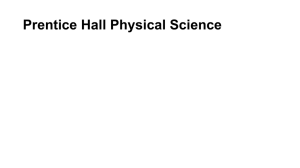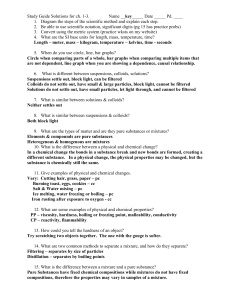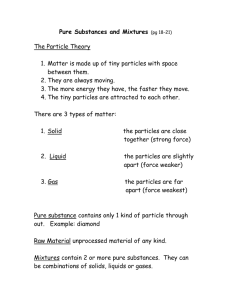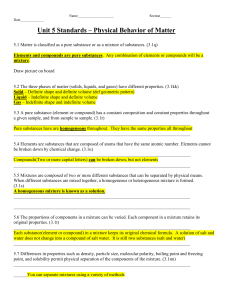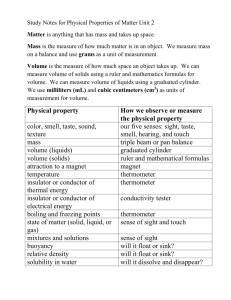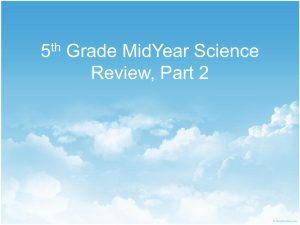Unit 6 Overview
advertisement
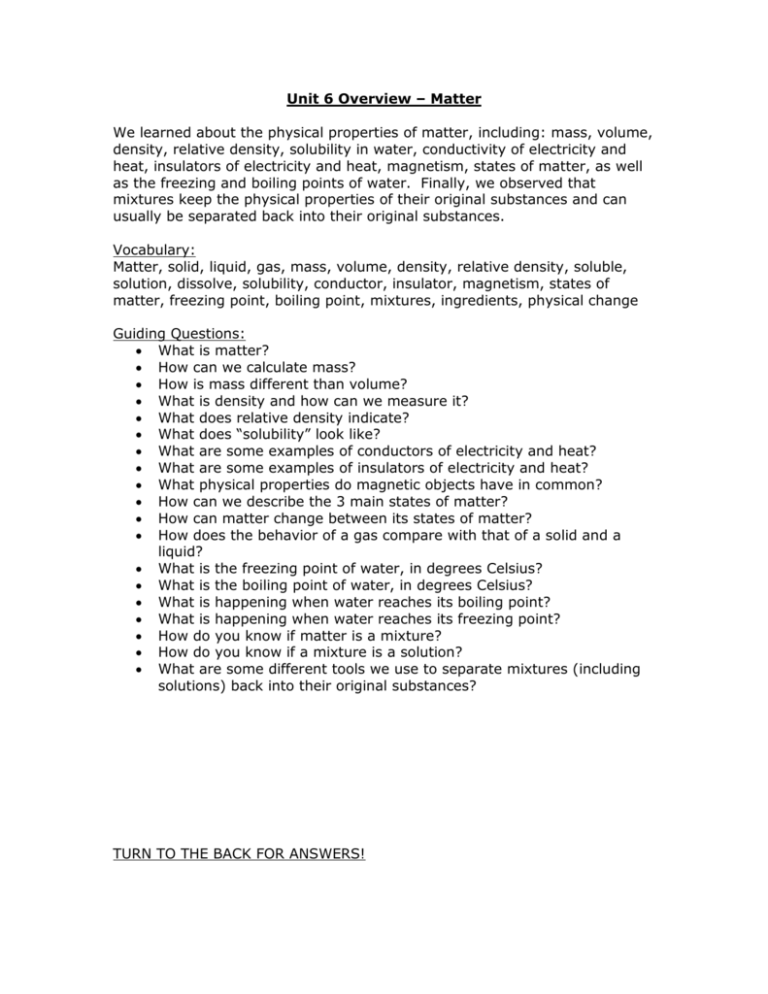
Unit 6 Overview – Matter We learned about the physical properties of matter, including: mass, volume, density, relative density, solubility in water, conductivity of electricity and heat, insulators of electricity and heat, magnetism, states of matter, as well as the freezing and boiling points of water. Finally, we observed that mixtures keep the physical properties of their original substances and can usually be separated back into their original substances. Vocabulary: Matter, solid, liquid, gas, mass, volume, density, relative density, soluble, solution, dissolve, solubility, conductor, insulator, magnetism, states of matter, freezing point, boiling point, mixtures, ingredients, physical change Guiding Questions: What is matter? How can we calculate mass? How is mass different than volume? What is density and how can we measure it? What does relative density indicate? What does “solubility” look like? What are some examples of conductors of electricity and heat? What are some examples of insulators of electricity and heat? What physical properties do magnetic objects have in common? How can we describe the 3 main states of matter? How can matter change between its states of matter? How does the behavior of a gas compare with that of a solid and a liquid? What is the freezing point of water, in degrees Celsius? What is the boiling point of water, in degrees Celsius? What is happening when water reaches its boiling point? What is happening when water reaches its freezing point? How do you know if matter is a mixture? How do you know if a mixture is a solution? What are some different tools we use to separate mixtures (including solutions) back into their original substances? TURN TO THE BACK FOR ANSWERS! Essential Facts: Matter is made of particles (mass) and takes up space (volume). We can calculate mass using a triple beam balance, pan balance, and a digital scale. Mass is the amount of matter that an object contains. Volume indicates the amount of space the matter occupies. Density is the comparison of mass to volume. In other words, density indicates how “much stuff” is squeezed into a certain space. Relative density indicates : “Compared to this type of matter, this matter has less density,” for example. We use density tubes to see relative density. The matter with less density floats on top of matter that has more density. Solubility “looks like” particles disappear in another substance (they really don’t disappear but get really really small), or the particles seem to divide out and spread out completely in another substance. This is called dissolving. Soluble = “Dissolve – able” Examples of conductors of heat and electricity are usually metallic solids, such as: copper wire, steel paper clips, coins, magnets. Examples of insulators of heat and electricity are usually not metallic, such as: plastic, rubber, cloth, wood, and Styrofoam. Magnetic objects must contain a certain type of metal (iron, nickel, or cobalt). The 3 main states of matter include: solids, liquids, and gases. Matter changes between states due to: heat being lost or gained. The behavior of a gas: particles have the most energy, most spread out, take the shape of their container, escape quickly, might look invisible to our eyes, low density, high volume, low mass. The behavior of a liquid: particles slide past each other but are pretty close together, take the shape of their container on the bottom, can be poured. The behavior of a solid: particles do not have much energy and are close together, maintain their shape (do not take the shape of their container). The freezing point of water is equal to 0 degrees Celsius (32 degrees Fahrenheit). During freezing, liquid is losing heat and particles start changing from liquid into a solid. The boiling point of water is equal to 100 degrees Celsius (212 degrees Fahrenheit). During boiling, liquid is gaining heat and particles start changing from liquid into a gas. You know if matter is a mixture if it contains separate substances. You know if a mixture is a solution if its particles are dissolved in another substance (soluble). We can use a variety of following tools/methods to separate mixtures (and solutions):magnets, tweezers, strainers (colanders), coffee filter/funnel/with water, evaporation, boiling (hot plate).
